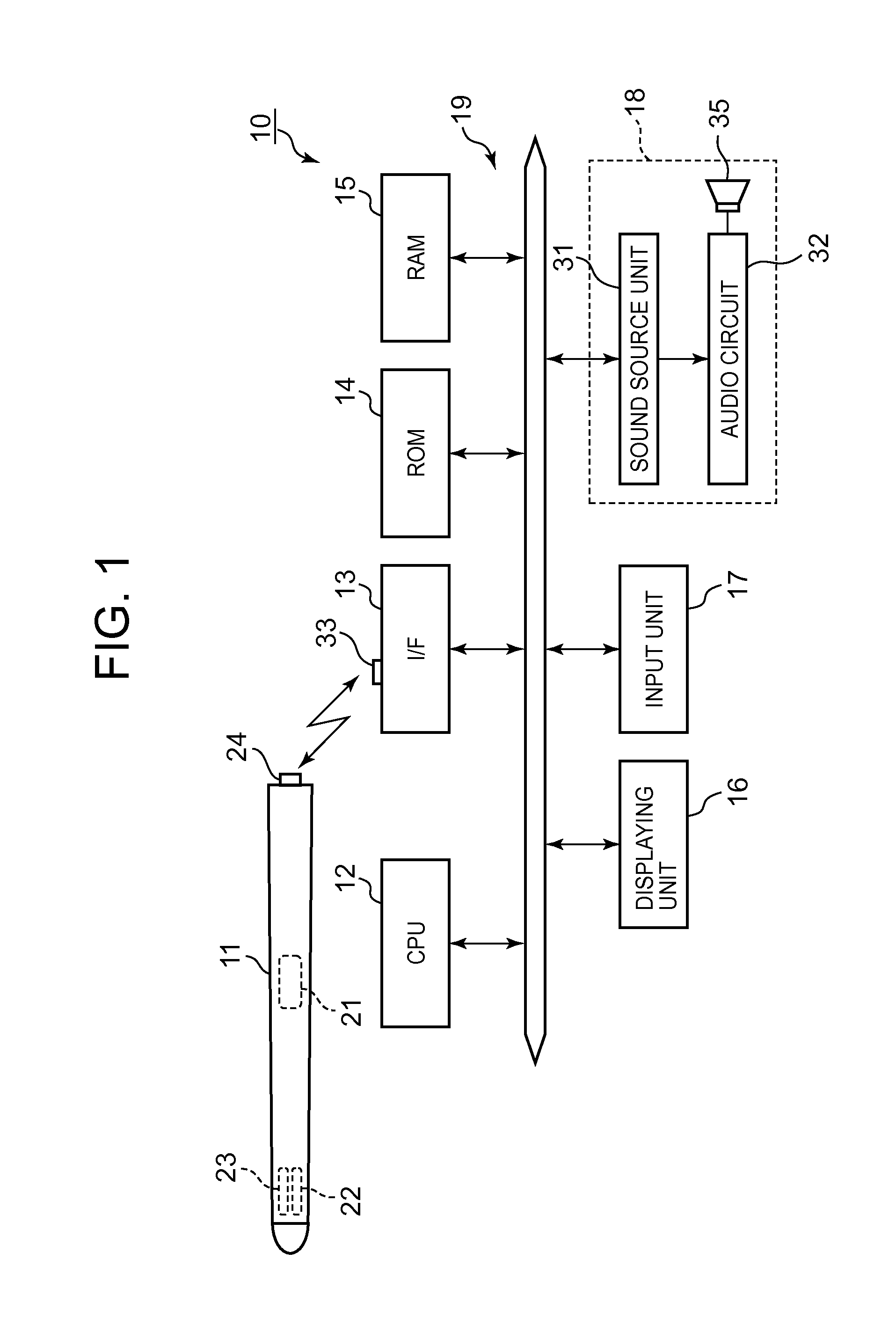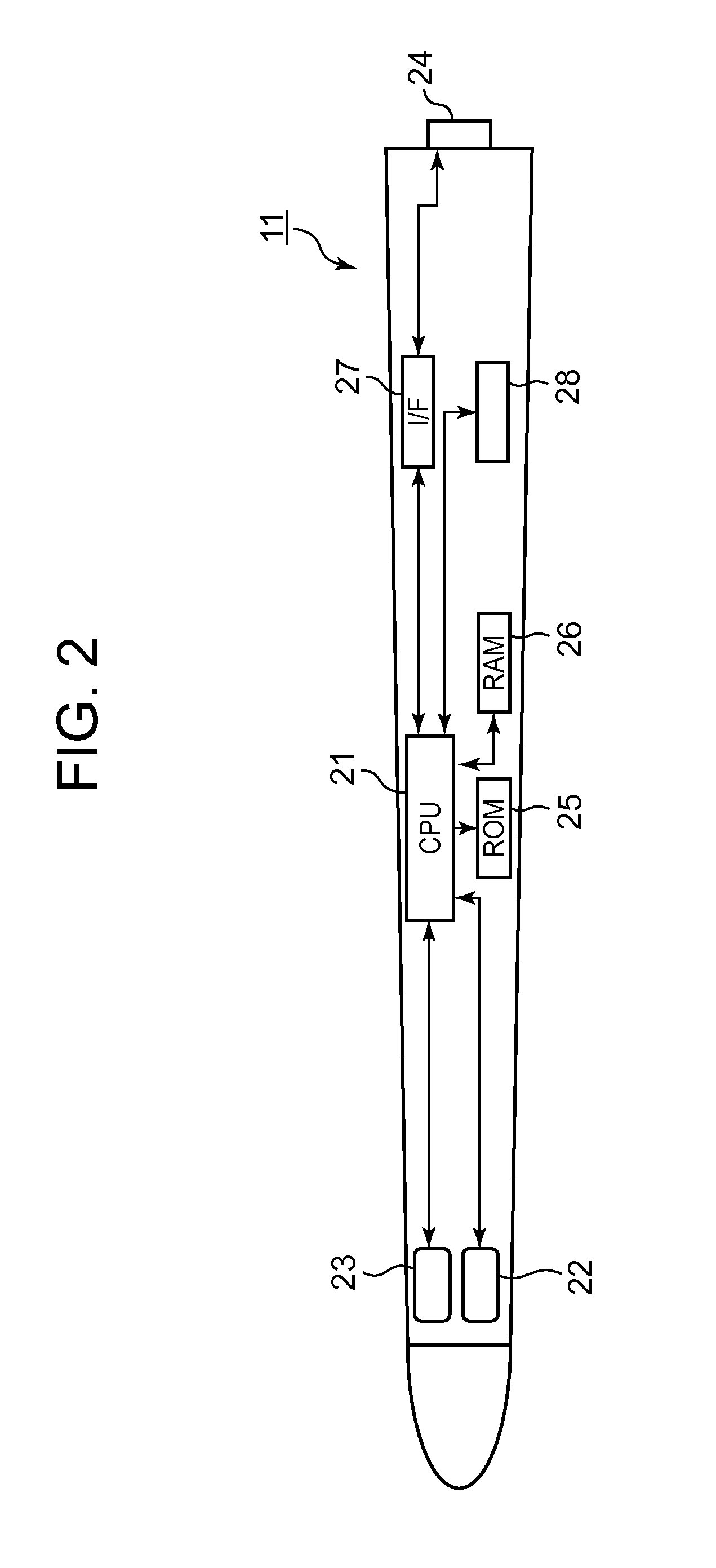Performance apparatus and electronic musical instrument
a performance apparatus and electronic technology, applied in the direction of instruments, electrophonic musical instruments, measurement devices, etc., can solve the problems of difficult for a player to change musical tones as he or she, and it is difficult to generate musical tones of the tone color desired by the player, so as to achieve the effect of easy change of musical tone elements including tone colors
- Summary
- Abstract
- Description
- Claims
- Application Information
AI Technical Summary
Benefits of technology
Problems solved by technology
Method used
Image
Examples
first embodiment
[0039]FIG. 2 is a block diagram of a configuration of the performance apparatus 11 in the invention. As shown in FIG. 2, the performance apparatus 11 is equipped with the geomagnetic sensor 22 and the acceleration sensor 23 in the head portion of the performance apparatus 11 opposite to its base portion. The portion where the geomagnetic sensor 22 to be mounted on is not limited to the head portion, but the geomagnetic sensor 22 may be mounted on the base portion. Taking the head of the performance apparatus 11 as the reference (that is, keeping eyes on the head of the performance apparatus 11), the player often swings the performance apparatus 11. Therefore, since it is taken into consideration that information of the head position of the performance apparatus 11 is obtained, it is preferable for the geomagnetic sensor 22 to be mounted on the head portion of the performance apparatus 11. It is also preferable to mount the acceleration sensor 23 in the head portion of the performanc...
second embodiment
[0085]FIG. 14 is a flow chart of an example of the space setting process to be performed in the invention. CPU 21 of the performance apparatus 11 judges at step 1401 whether or not a center setting switch of the input unit 28 is kept on. When it is determined NO at step 1401, then the space setting process finishes. When it is determined YES at step 1401, CPU 21 judges at step 1402 whether or not the center setting switch has been turned on again. When it is determined YES at step 1402, CPU 21 reads position information from RAM 26, and stores in RAM 26 the read position information as position information (coordinate (xc, yc, zc)) of the central position C (step 1403).
[0086]When it is determined NO at step 1402, that is, when the center setting switch is kept on, or after the process at step 1403, CPU 21 judges at step 1404 whether or not the center setting switch has been turned off. When it is determined NO at step 1404, then the space setting process finishes. When it is determi...
fifth embodiment
[0114]FIG. 20 is a flow chart of an example of the sound-generation timing detecting process to be performed in the invention. The processes at steps 2001 to 2003 are performed substantially in the same manner as those at 901 to 903 in FIG. 9. When it is determined YES at step 2002, CPU 21 reads an acceleration sensor value (x-component, y-component, z-component) (step 2004) to calculate a sensor resultant value (step 2005). As described above, the sensor resultant value is given by the square root of the sum of the squares of the x-, y- and Z-components of the tri-axial acceleration sensor.
[0115]Then, CPU 21 judges at step 2006 whether or not the acceleration flag in RAM 26 is set to “0”. When it is determined YES at step 2006, CPU 21 judges at step 2007 whether or not the sensor resultant value is larger than a value of (1+a)G, where “a” is a positive fine constant. For example, if “a” is “0.05”, CPU 21 judges whether or not the sensor resultant value is larger than a value of 1.0...
PUM
 Login to view more
Login to view more Abstract
Description
Claims
Application Information
 Login to view more
Login to view more - R&D Engineer
- R&D Manager
- IP Professional
- Industry Leading Data Capabilities
- Powerful AI technology
- Patent DNA Extraction
Browse by: Latest US Patents, China's latest patents, Technical Efficacy Thesaurus, Application Domain, Technology Topic.
© 2024 PatSnap. All rights reserved.Legal|Privacy policy|Modern Slavery Act Transparency Statement|Sitemap



